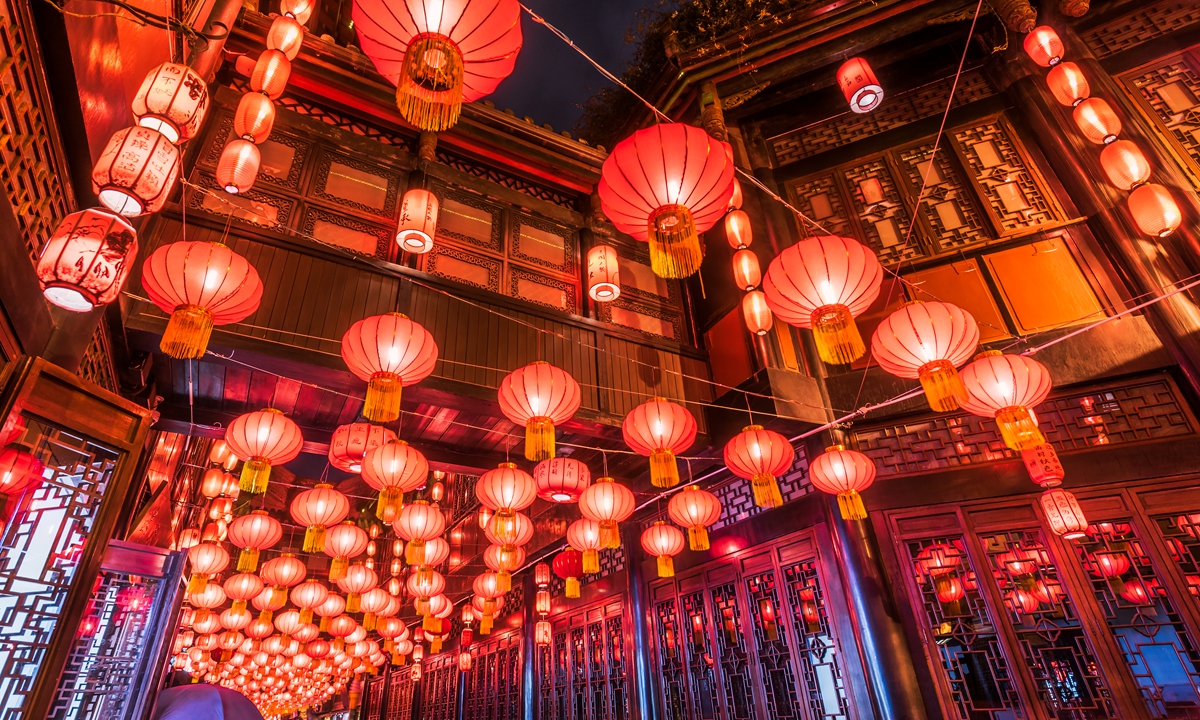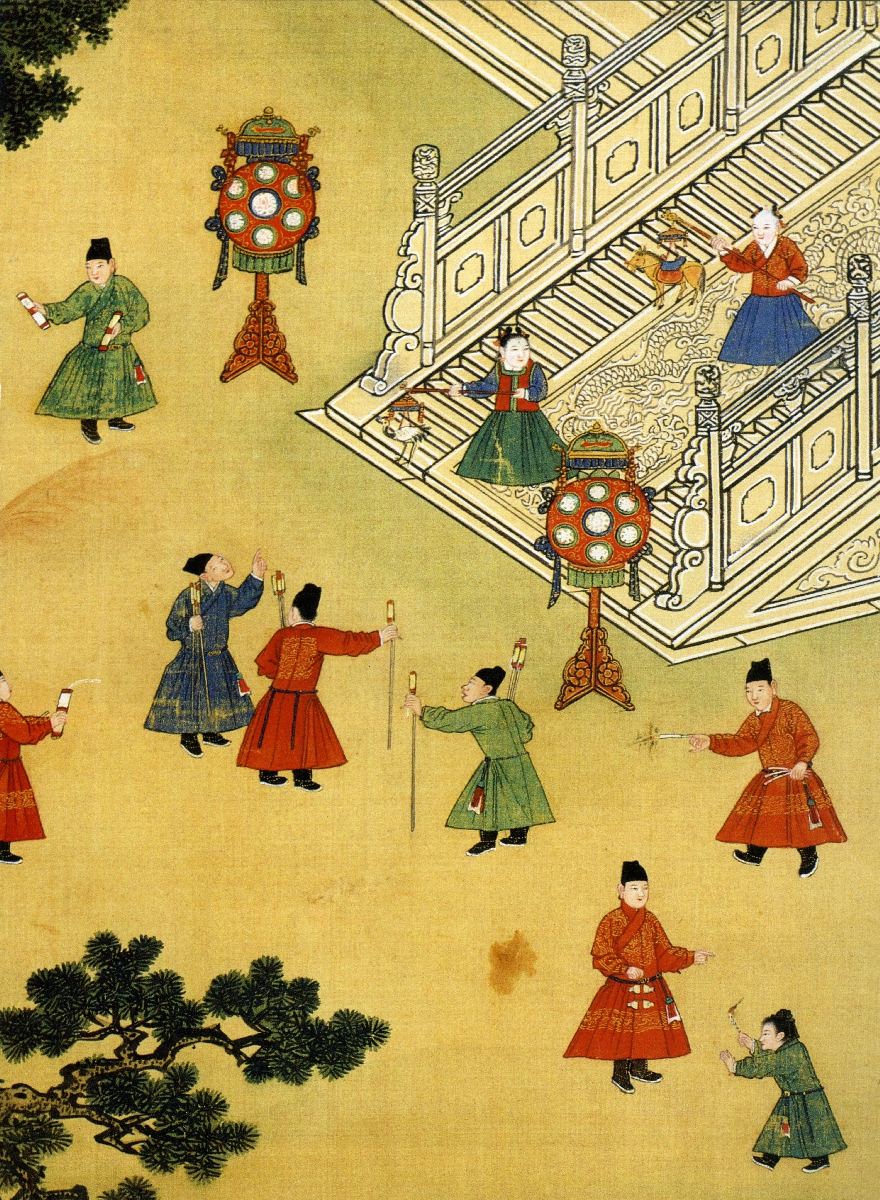
Photo: VCG
Editor's Note:With the 2023 Lantern Festival coming on Sunday, diverse celebrations are being prepared around the world for the traditional carnival. Marking the first full moon of the year according to the Chinese calendar, the festival is a time when Chinese people head out from home to wander through beautiful lantern shows and express their best wishes for a new year.
Handed down for thousands of years, the Lantern Festival still means a lot to Chinese and people from other regions around the world. The tradition of celebrating the festival is also being inherited and innovated on in modern society, reflecting the strong vitality of traditional Chinese culture.Looking at one particular mural in China's world-famous Dunhuang Mogao Grottoes, a major repository of ancient China's Buddhist art, visitors may notice a building fully decorated with lanterns surrounded by figures wearing gorgeous costumes who dance and light more lanterns around the building. According to experts, this scene is theorized to depict the lively atmosphere of a Tang Dynasty (618-907) palace banquet during the Lantern Festival.
The Lantern Festival, also known as the Shangyuan Festival, is a traditional Chinese festival celebrated on the 15th day of the first month of the Chinese calendar, which means it also comes with a full moon. According to Chinese folk tradition, in addition to eating yuanxiao - a kind of glutinous rice ball that also symbolizes reunion and happiness - people also light up colorful lanterns, set off fireworks and take a stab at figuring out riddles written on the sides of lanterns on this full moon night.
One of the most significant festivals of the year starting with the Han Dynasty (206BC-AD220), it flourished even more during the later Tang and Song (960-1279) dynasties. Many cultural relics from the past can inform us about the festival, including its cultural and religious role and how royalty and common folk celebrated the night in ancient times.
"The Shangyuan Festival is connected to the lantern, as that is a significant symbol of expelling darkness in Chinese belief. During the festival, Chinese people light colorful lanterns to repel misfortune and welcome a bright new year, allowing the Chinese New Year to reach full swing," Chen Lüsheng, a renowned museologist and researcher at the National Museum of China, told the Global Times on Wednesday.
Eternal lightThere are several different explanations about the origin of the Lantern Festival, but researchers can confirm that the custom of igniting lanterns at the festival dates back to the reign of Emperor Ming of the Han Dynasty, a time when Buddhism was growing in China.
Lanterns are a must-have decoration for the festival, so making lanterns is a skill that has become an important folk art, according to Chen. These colorful lanterns have lit up the centuries as the festival has been passed down from generation to generation and continue to shine today as a symbol of traditional Chinese culture.
One lantern at the Palace Museum that was made during the Qing Dynasty (1644-1911) is a perfect example of this.
The lantern's skeleton is made of iron wire while the surface is covered in a layer of silk. A colorful and festive picture of a boy holding a fish was painted on both sides of the lantern, representing the auspicious meaning of "good harvest" and "best wishes."
Chen said that hanging lanterns at night was originally a privilege of the royal family and so became a symbol of power and fortune in ancient times. But during the festival, ordinary people were also able to appreciate these colorful lanterns hanging outside just like nobles, which increased people's enthusiasm and fondness for the festival.
Discovered in the Astana Tombs in Northwest China's Xinjiang Uygur Autonomous Region, a piece of brocade fabric dating to the Sui (581-618) and Tang dynasties depicts an ancient "lantern tree." This relic is evidence of the far reach of the Lantern Festival, which originated in China's Central Plains region but expanded and was celebrated in regions thousands of kilometers away.
The brocade work features a pair of sheep and chickens. In Chinese culture sheep are also an auspicious symbol, as such the work represents people's hope for the future while celebrating the ancient Lantern Festival, Sun Weiguo, a historian from Xinjiang region, told the Global Times on Wednesday.

A Ming Dynasty painting showing a Lantern Festival celebration at the imperial palace Photo: VCG
Symbol of prosperity Other works such as ancient paintings also reveal the special status of the Lantern Festival.
A painting in the Palace Museum depicts the Qing Dynasty's Qianlong Emperor celebrating the festival with his children in the Forbidden City. The children can be seen setting off fireworks and enjoying diverse activities in the painting.
Another painting of the Ming Dynasty (1368-1644) Xianzong Emperor celebrating the Lantern Festival also depicts many traditional activities.
Chen said that the grand celebrations depicted in the paintings are a symbol of flourishing times in Chinese history; when delegations from other countries visited China at the time they could see the country's power and prosperity.





